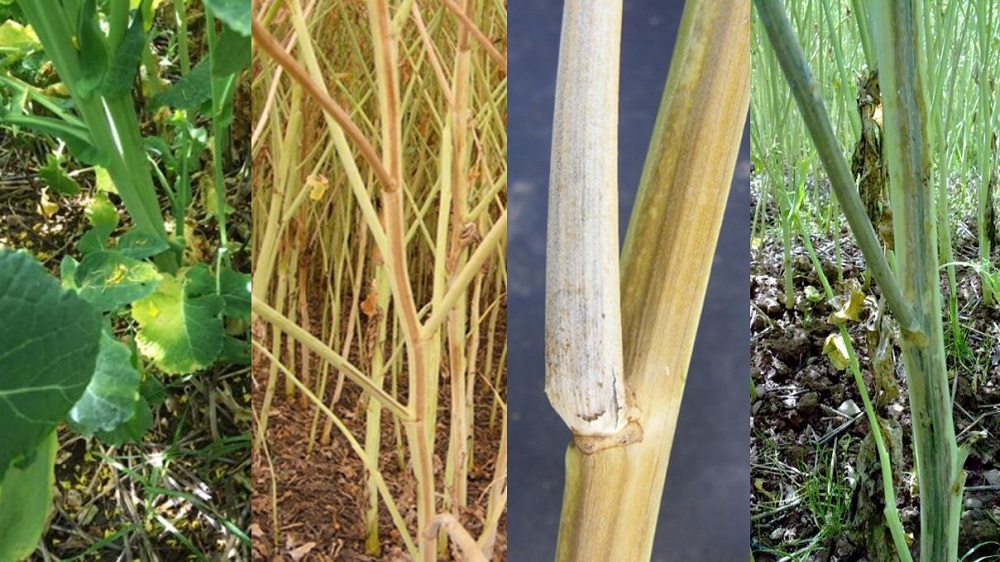RL unveils verticillium stem stripe data
Wednesday, 23 August 2023
The first ever Recommended Lists (RL) oilseed rape verticillium stem stripe data has been released.
It follows nearly a decade of work to produce robust resistance data for the oilseed rape disease.
Based on a mean verticillium disease index (0–100 scale), the preliminary results show useful variation for the varieties in trial.
The next edition of the RL (2024/25, due out in November) will include disease resistance information to help farmers manage this soilborne disease.
Disease research
Caused by Verticillium longisporum, the disease was first detected in England in 2007, with differences in symptom occurrence and severity noted between varieties.
AHDB funding led to a collaboration between NIAB and ADAS that identified consistent and reproducible differences in verticillium infection levels between varieties.
Catherine Harries, who helps manage RL disease data, said:
“Our regular reviews, including the current RL review, show that growers rate disease and pest resistance as one of the most important variety features. It is why AHDB invests in the provision of robust resistance data.
"The groundwork on verticillium stem stripe laid the foundation to assess the disease in the RL trial system.”
Disease assessments
Following the research, the RL trial system expanded in 2021 to include two trial sites each year to assess verticillium stem stripe levels.
The trial sites are judged to have a relatively uniform distribution of the disease, with artificial inoculation used (as appropriate) to help ensure this.
Each site features four replicates of each variety to minimise site variation effects.
Trial management is similar to the main oilseed rape trial series, except fungicide applications are limited to a single autumn treatment targeted at stem canker.
Additionally, plots are not harvested, as plants are pulled up early as part of the disease assessments.
Crops are carefully monitored to determine the optimum assessment timing – too early or too late would potentially underestimate symptom incidence and severity.
In each plot, 30 stems are assessed for external (shredding and black microsclerotia) and internal (grey discolouration, revealed by scraping stems) symptoms (figure 1), with the percentage of the stem circumference affected recorded.
The data is used to calculate a verticillium stem stripe index (0 to 100, where 0 represents no symptoms on any stem and 100 represents all stems severely affected or dead).
Disease symptoms
 ADAS
ADAS
Figure 1. Various symptoms of verticillium stem stripe. Left to right: Yellowing of half a leaf in mid-May. Classic stripes along the stem length in early July. Close-up of an affected branch (with clear distinction between the brown stripe and greener plant tissue). Manually scraped stem showing internal vascular staining.
Disease data
The preliminary data covers six trials (including limited data from two additional trials in 2023) in Cambridgeshire, which was one of the first UK counties to be severely impacted by the disease.
Download the verticillium stem stripe data
No varieties were completely resistant, with relatively high disease levels recorded at one site in 2022, where the lowest score recorded was 37.0.
Across trials, the most resistant and susceptible varieties had a mean score of 11.2 and 44.1, respectively.
In these results, variety mean values need to be at least 12.6 LSD (least significant difference) apart for the difference to be considered significantly different.
Although none was fully resistant, varieties with greater resistance are likely to produce fewer fungal spores and may help reduce long-term disease pressures.
The resistance data does not indicate tolerance. Some susceptible varieties may yield well, even under relatively high disease pressures.
Verticillium stem stripe is a relatively new common name that better reflects the symptoms (previously the disease was called verticillium wilt).
Topics:
Sectors:
Tags:


